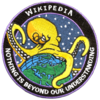| This article is rated Start-class on Wikipedia's content assessment scale. It is of interest to the following WikiProjects: | |||||||||||||||||||||
| |||||||||||||||||||||
Untitled
editAll the entries for the TAT series of transatlantic telecoms cables, with the exception of TAT-1 -- ie TAT-2 to TAT-11, TAT-12/13 and TAT-14 contain statements like TAT-11 was AT&Ts 11th transatlantic telephone cable.
I'm deeply suspicious of the way in which it is implied that, with the exception of TAT-1, AT&T was responsible for the TAT series of cables.
My understanding was that all the TAT cables were the result of international consortia of telecoms administrations.— Preceding unsigned comment added by 62.253.128.7 (talk • contribs) 2002-09-09T22:37:24
Really should read things properly before commenting. Just noticed at the end of Transatlantic telephone cable (oops, wrong reference before)
All TAT cables are joint ventures between AT&T and some European telco, e.g. British Telecom.
which would tend to confirm that these statements about their being AT&T cables are misleading (though, arguably, not out-and-out untrue) — Preceding unsigned comment added by 62.253.128.7 (talk • contribs) 2002-09-09T22:47:45
A few days ago (15:18, 29 March 2006) this page was edited by 193.113.57.167 who adjusted the supposed number of circuits in the cable from 16 to 32. This may or may not be right for all I know, but it does disagree with the TAT-14 homepage https://www.tat-14.com/tat14/index.jsp, which claims the number to be 16. I don't know what the fact of the matter is so I'm just leaving notes here and on the user's talk page. — Preceding unsigned comment added by 217.40.213.68 (talk • contribs) 2006-04-07T17:43:29
TAT-14
editAll the knowledge on the TAT-14 site is correct, 16 wavelengths per STM-64 per fiberpair, 4 fiberpairs per ring. It's a consortium between several telecom providers, like BT, AT&T, KPN, France Telecom.
I'm an engineer in the station Katwijk for the TAT-14, keeping the ring Segment-I and Segment-J working and alive. If you want to know more about this cable system please leave a note. —The preceding unsigned comment was added by Meurkes (talk • contribs) 19:58, 3 January 2007 (UTC).
- Looking at the archive.org captures of the now defunct website, it looks like the original design capacity was 1.87 Tbps (although I wouldn’t be surprised if that was not really the original design capacity way back around 2000, 10 Gbps per wavelength at that time seems high) and the 3.xx lit capacity was the relevant number at the end. If I get no objections I’ll make these changes soon. BGPexpert (talk) 12:26, 8 May 2024 (UTC)
Terrorist Target Listing
editIs it really appropriate to publish the claim that the site is on a list of US-government designated targets susceptible to terrorist attack? I don't know Wikipedia policy on this, but leaving out the question of whether the list was classified (which I don't know either way), it seems like Wikipedia advising terrorists about good targets is a bad idea.
Incomprehensible sentence
edit"...is considered part of many critical points in a logistic chain" This simply doesn't parse. I'd fix it, but have no idea what it was supposed to be saying. — Preceding unsigned comment added by 99.243.22.211 (talk) 02:50, 15 July 2011 (UTC)
System construction / data rates
editNumbers don't add up at present.
"TAT-14 uses four pairs of fibres—two pairs as active and two as backup. Each fibre in each pair carries 16 wavelengths in one direction, and each wavelength carries an STM-64 (9,621,504 kbit/s as payload)."
suggests that the total capacity is 9621504kbit/s (per wavelength) x 16 (wavelengths / fibre) x 2 (active fibres) = 293.625Gbit/sec - nowhere near the quoted 9.38Tbit/s
More research required! — Preceding unsigned comment added by 31.52.21.236 (talk) 08:19, 27 June 2015 (UTC)
